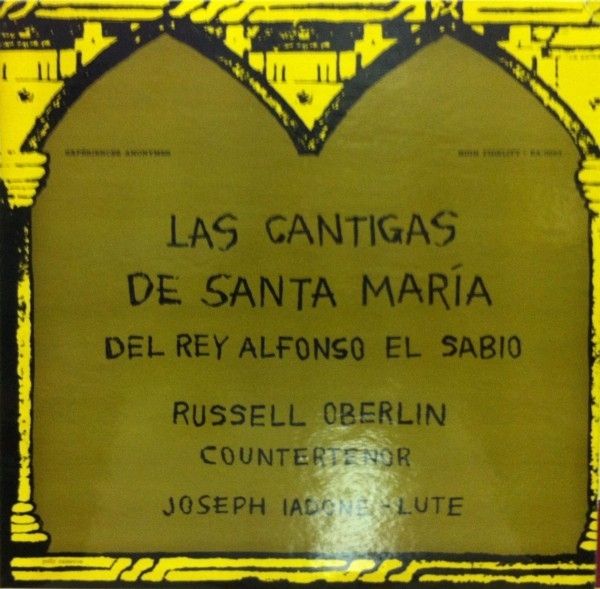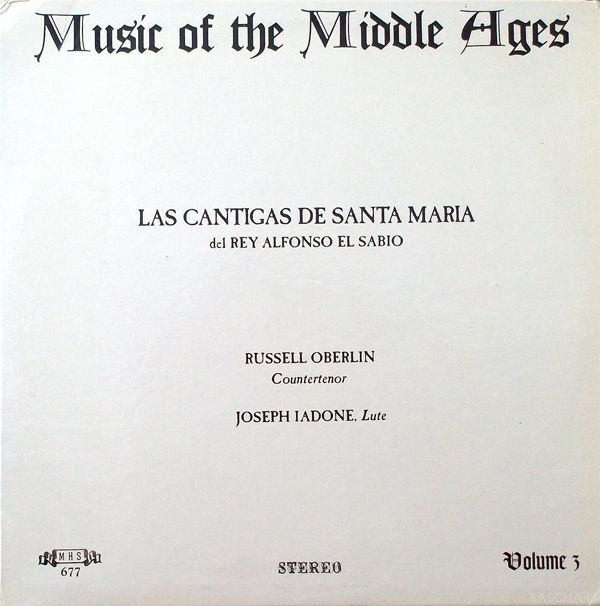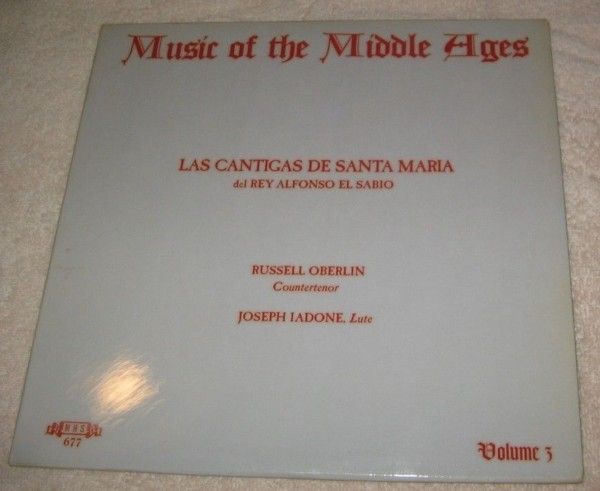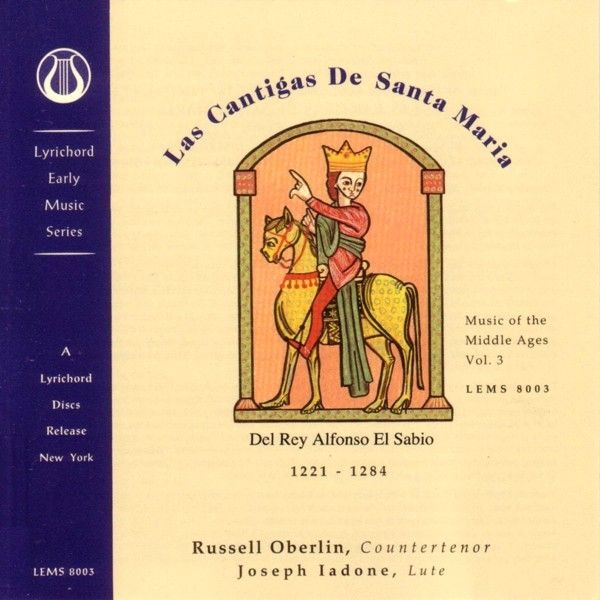Las Cantigas de Santa Maria del Rey Alfonso el Sabio
Russell Oberlin

medieval.org
Lyrichord Expériences Anonymes EAS-0023 (LP), 1958
. . .
Musical Heritage Society MHS 677S (LP)
. . .
Lyrichord Early Music Series LEMS 8003 (CD), 1994
1. Porque trobar [2:37]
Prologo
2. Santa Maria amar [5:25]
CSM 7
3. A Virgen sempr' accorer [2:44]
CSM 97
4. Muit' amar devemos [1:12]
CSM 36
5. Quen Jesu-Christ'e ssa Madre veer [4:56]
CSM 261
6. Madre de Deus Nostro Sennor [1:39]
CSM 330
7. Quen bõa dona querrá loar [1:36]
CSM 160
8. Fazer pode d'outri vive-los seus fillos [2:55]
CSM 118
9. Oraçón con piedade [1:30]
CSM 205
10. Quem por serviço da Virgen [3:51]
CSM 364
11. En todo tempo faz ben [1:46]
CSM 111
12. Virgen Madre groriosa [7:10]
CSM 340
Russell Oberlin, Countertenor · Joseph Iadone, Lute
Recorded: Esoteric Sound Studios, New-York City

Music of the Middle Ages - Volume 3
Songs
Las Cantigas de Santa Maria
del Rey Alfonso El Sabio, 1221 -1284
Alfonso's
court was the center of much intellectual and artistic activity
throughout his reign. The works produced there include many translations
from the Arabic - treatises on astronomy, on chess, and a translation
of the legend of Mahomet's journey to the other world - legal works,
such as Las Siete Partidas, historical works, such as the Estoria de España and the General Estoria (an uncompleted history of the world), and religious works, such as the Cantigas de Santa Maria.
These works all bear Alfonso's name, though it is doubtful that all of
them were written by him personally. We know that Alfonso kept a large
number of Arab, Jewish and Christian scholars, as well as artists,
working at his court; and it seems more likely that in many cases,
though certainly not all, he acted as a sort of editor and compiler. As
far as the Cantigas are concerned, it is not possible to say how much of the work is his own, though no doubt a good deal of it is.
The texts of the Cantigas de Santa Maria
are in Galician, a language much used in Spain for literary purposes
during the Middle Ages. Their subject matter deals almost exclusively
with the miracles of the Virgin Mary. In the original manuscripts, the
songs are arranged in groups of ten, nine relating miracles of the
virgin followed by a tenth in praise of the Virgin. The stories of these
miracles were well known all over Europe at the time, and versions of
them in verse and prose were written down in many countries. Some,
however, seem to have been popular only in Spain, and deal with local
matters. There are 403 Cantigas de Santa Maria preserved, and two smaller collections - 13 Cantigas de Fiestas de Santa Maria and 10 Cantigas de Fiestas de Nuestro Senor y Otras de Santa Maria, making a total of 426. All but three have music.
There
has been a great deal of controversy among literary historians and
musicologists concerning the origins of medieval song. Much of this
controversy, particularly among musicologists, has centered around the Cantigas de Santa Maria.
The principal question has been the one of Arab influence. There are
musicologists who deny any such influence whatsoever, or refuse to
accept a theory of Arab origin until some "proof" is offered - a safe
statement, since the Arabs did not write down their music. In the
meanwhile, these men point to what they believe is evidence of the
origin of these melodies in Gregorian chant and other western liturgical
music. On the other hand, some writers on the subject have gone so far
as to say that the Cantigas are Arab melodies, composed by the Arabs in
Spain, and used by Spanish poets.
Of course the Cantigas
use many different kinds of melody, as any examination of the collection
must show. It would seem some - a very small number - derive directly
from western chant; a large number seem to have an indirect relation to
chant but have been transformed by a uniquely Spanish kind of lyricism; a
few clearly derive from popular song; but a large group, perhaps the
largest of all, have no relation to chant whatsoever, nor can they be
analyzed according to the western modal system. It would seem reasonable
to assume that these melodies were composed with Arab models in mind,
and that some of them may even be Arab melodies; further, that what we
hear as uniquely Spanish lyricism is due, at least in part, to the
presence of Arabs in Spain for over 500 years before these songs were
written.
The songs on this recording were selected with the idea of representing the different types of melodies contained in the Cantigas.
It should, however, be clearly understood that any such classification
according to 'type' of melody is a very general one. Actually, every
song in this collection (discounting the few instances where an entire
melody is used a second time) is remarkably different from every other.
Nevertheless, some broad basis for selection was necessary. Number 160,
and to a lesser degree number 340, are of the "type" that derive
directly from Gregorian chant; numbers 36, 205, and perhaps 111 are
based oil popular song; numbers 118, 330, and 364 seem to be based more
directly on possible Arab models.
The Cantigas are
strophic songs - that is to say the melody is repeated with each verse.
It has not been possible, however, for reasons of space, to record all
the verses of any cantiga, since the number of verses can be
anywhere from five to thirty. But rather than record only one verse of
each cantiga, two and occasionally three have been recorded, for, in
order to understand the principles of strophic song, it is necessary to
hear different sets of words to a repeated melody.
The texts with music of the Cantigas
are preserved in three manuscripts written in the 13th and 14th
centuries. The edition of the music and its transcription into modern
notation here used is that of Higinio Anglés, and it should be noted
that Anglés differs with the opinions stated in this article and feels
that any Arab influence on the Cantigas is negligible. There is no
indication in the original manuscripts as to how these songs were
accompanied,
through it is probable that they were performed in a variety of ways,
The accompaniments for lute used on this record are by myself, and the
use of finger cymbals in cantigas 36 and 205 is the suggestion of Mr.
Russell Oberlin.
SAVILLE CLARK

Musical and Literary Background of Cantigas by Ernesto G. Da Cal
Alfonso
X, King of Castile (1221-84), better know as "Alfonso el Sabio", the
"Learned", was, politically speaking, a most unfortunate and unwise
monarch. His reign was marked by strife, dissension and war - with his
brothers, with his son, with his people and with the Pope - though he
won some victories against the Moors. His failures as a statesman,
however, were amply offset by his achievements as an astonishingly
active intellectual leader of his times and of his people. His pet,
ambitious dream of becoming Holy Roman Emperor ended miserably in
sadness and frustration, but as a compensation, History has bestowed
upon him the greater title of "Emperor of Culture". His encyclopedic
interests encompassed the sky and the stars, law, science and the arts,
education, chronology, games and sports, gems, the Koran, the Talmud and
the Caballa [sic] . Around him he gathered the best minds he
could find among Christian, Moorish, and Jewish scholars as well as
musicians, poets and craftsmen.
Alfonso's native tongue was
Castilian, the central Romance dialect of the Iberian Peninsula, known
today as Spanish. He not only had its spelling systematized but also
laid the foundations of Spanish prose in his writings. As a poet,
however, we must assume that he did not find entirely to his liking the
strong, epic and still rough-hewn sonorities of the idiom of the
Castilian plains, for he rejected it, as an instrument of subjective
expression, in favor of the softer, more melodic and more delicate
rhythms of Galician, the Neo-Latin dialectal of Northwestern Spain. It
is possible that he knew this tongue from childhood, for it has been
said that he grew up in Galicia, but there are other factors explaining
Alfonso's choice.
About the end of the 12th century Galician had
become the vehicle of a vigorous lyrical movement, the first in the
Peninsula. The pilgrimages to St. James of Compostela, the greatest
shrine of Christendom after Rome and Jerusalem, had exposed Galicia,
more than the Castilian lands, to foreign influences. The pilgrims
brought with them the elaborate amatory poetry of the troubadours of
Provence which mixed with a native Celtic vein of folk lyricism produced
a poetic flowering of remarkable quality and proportions. From the 13th
century on, this current of poetry was abundantly cultivated. Princes,
nobles, merchants, soldiers, priests and jongleurs, all contributed.
Galician, which was already the language of the new kingdom of Portugal,
became also the medium of lyrical expression of Castile. Until we reach
the threshold of the Renaissance, it was the accepted practice among
the Castilian poets not only to compose their love and satirical lyrics
in the manner of their Galician-Portuguese neighbors but in their tongue
as well. Then the imperial role assumed by Castile in the 15th century,
and the resulting literary ascendancy of its language, pushed this
poetry first into rhetorical decadence and then into oblivion. It
remained forgotten and unknown to later generations until the end of the
19th century, when the Cancioneiros (or Song Books) in which it
was preserved were exhumed from dusty archives. These Song-books
revealed a treasure of lyricism which lovers of poetry "can as ill
afford to ignore as the poems of Chaucer or any other priceless heritage
of song" (Aubrey Bell).
King Alfonso, therefore, was not alone
in his preference for Galaician as the instrument for his verse, both
profane - and indeed it was at times! - and religious, as in the
charming collection of songs to the Virgin, known as the Cantigas de Santa María.
The
Cantigas belong to the medieval current of the Marian cult which became
more marked in the 12th and 13th century mainly due to the influence of
St. Bernard and the Cistercian Order, In the worship of "Our Lady" men
saw the worship of all womanhood. The troubadour doctrine of "amour
courtois" evolved mystically, finding in the Virgin Mary a symbol of
absolute love and immaculate service to a feminine idea, devoid of all
sin and carnality. Mariolatry had always been particularly intense in
the Iberian lands. Alfonso became the most distinguished "troubadour of
the Virgin" - as he calls himself in the Cantigas.
The Cantigas
are a vast compilation of Marian lore and the compositions it contains
span a long period of Alfonso's life. Four manuscripts survive: one in
the National Library at Madrid, two in El Escorial, and another in the
National Library in Florence. They apparently represent at least two, if
not three, distinct editions of the collection. The King kept enlarging
the scope of his initial plan, adding new miracles as he netted them
from many sources, national and foreign, oral and written. One of the
Escorial manuscripts (written after 1279) represents the most complete
version and it is profusely illustrated with illuminated miniatures.
Scholars
have questioned whether the authorship of the whole book should be
credited to Alfonso. Internal evidence indicates a likelihood that he
may have commissioned to jongleurs in his service the miracles
that held a lesser appeal for him; he may have found other miracles
already versified; but it is generally accepted that he composed the
major part of them. His main written sources were two famous medieval
compilations of Marian miracles: one in Latin (Speculum Historale, by Vincent de Beauvais), the other in Romance (Les Miracles de la Sainte Vierge,
by Gautier de Coincy). Naturally he disclaimed all originality of theme
but he shows quite a flair for variety of selection. The range of these
miracles is a wide one - from the delicate and heavenly to the earthy
an racy - in true medieval fashion. A profound and delightfully naive
confidence in the boundless compassion, or rather in the infinite
tolerance of the Mother of God towards the sins of man, pervades all
these songs. Through them we get a glimpse of the medieval soul, with
its solid faith, its crude beliefs and simple notions of the
supernatural, its charming and unbridled fantasy, its unconscious
irreverence, and its innocent mixture of the human and the divine.
The
metrical, rhyme and stanzaic patterns of the Cantigas offer an
extraordinary variety, and point to the "learned" character of Alfonso's
art. The theory has been propounded that not only the music but also
the meter of the lyrics was of Arabic origin - a thesis that has not
gone unchallenged. It is evident that the poet-King strove for
virtuosity of form, and for that he had at his command all the
complicated metrical devices of the troubadour technique of
Galician-Portuguese poetry. His was frequently carried away by this
technique. Some of his best verse is not to be found in the narrative
part of the miracles but rather in the essentially lyrical "Loores" in
praise of the Queen of Heaven, which were inspired both by Church hymns
and by the simpler folk vein of Galician love lyrics. While it may be
said that Alfonso was not a first rate poet, it is also true that on
numerous occasions he rose above rhetoric and proved that he could
clothe in real lyric grace the simple beauty contained, in these legends
and traditions.
Aside from their musical and literary value the
Cantigas constitute a colourful tapestry of the Middle Ages, a
variegated parade of social types - kings, knights, nuns, monks,
sailors, pilgrims, merchants, peasants, vagabonds - all of them candidly
portrayed in their daily lives.
The texts are given as
established by the Marquis of Valmar in his edition of the Cantigas
published by the Royal Spanish Academy in 1889. Summaries are provided
for the omitted parts of the miracles.

The court of Del Rey Alfonso El Sabio (a.k.a: "El Sabio the Wise"),
ruler of Spain from 1252 until 1284, was the center of a great output
of intellectual and artistic activity. The twelve songs on this
recording are some of the fruits of that activity, and certainly must
rank among the most beautiful melodies ever written for voice. These
works, sung in the original Galician language in which they were
written, are exquisitely performed by the legendary countertenor Russell
Oberlin, possibly the greatest countertenor of our century, with Joseph
Iadone, lute, under the direction of Saville Clark.
These
original stereo, 30 i.p.s. studio masters have been in the Lyrichord
vaults for over 30 years. Now available for the first time in stunning
digital sound on compact disc, they are likely to achieve a new standard
by which today's Early Music performances can be measured. Including
extensive liner notes by Saville Clark, Ernesto G. Da Cal, with
translations from Galician by Murrey Hargrove with Aurelio M. Espinosa.



